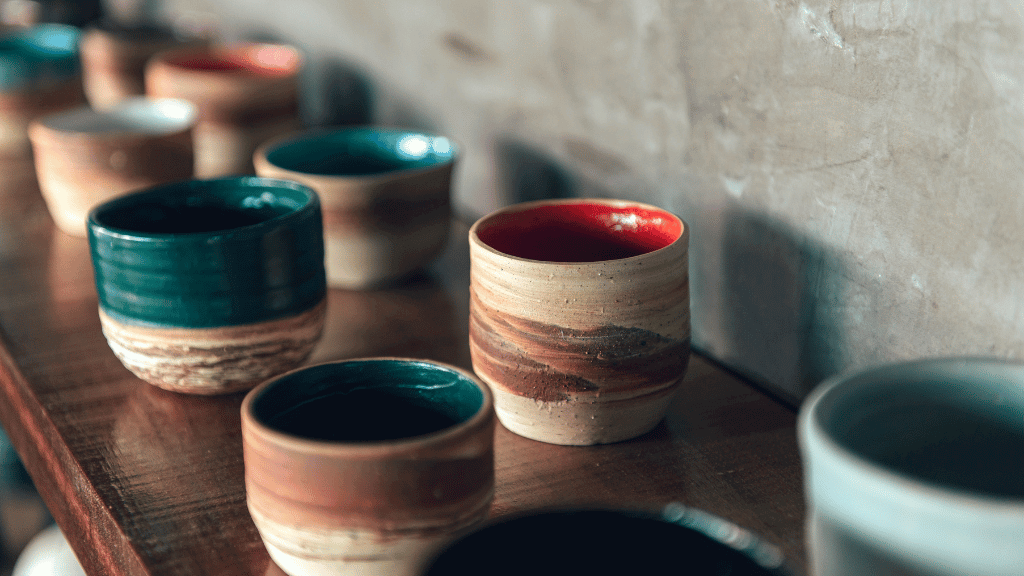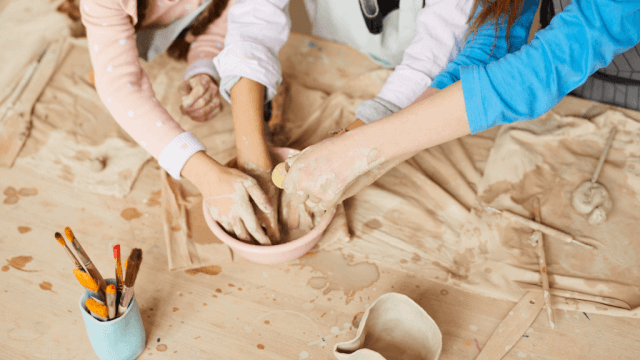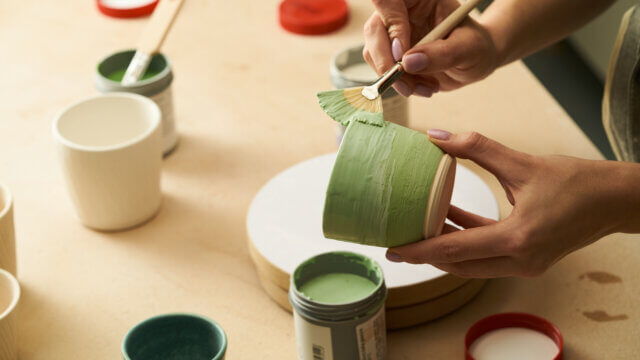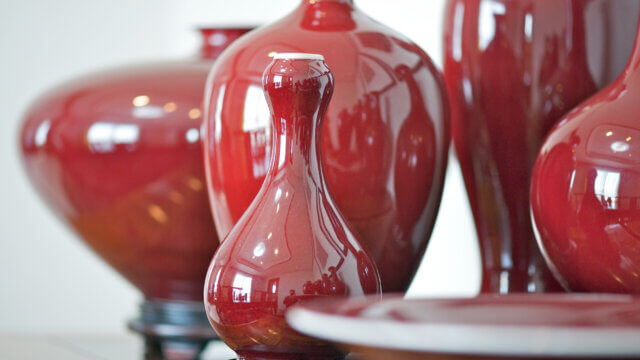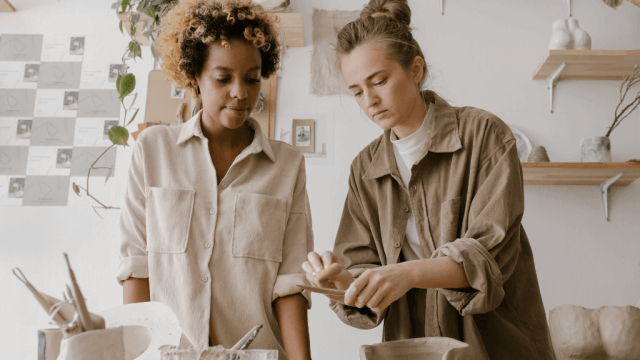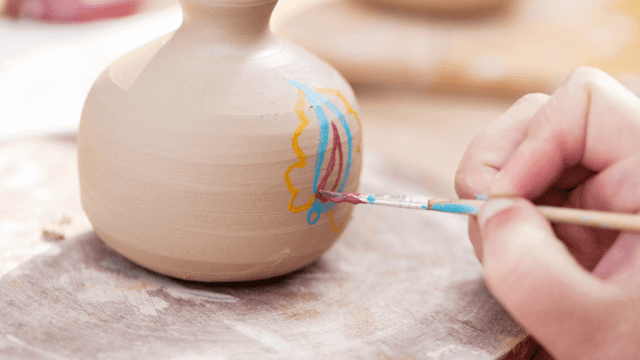Glazed pottery refers to ceramic pieces coated with a vitreous substance, typically silica and various metal oxides, fired at high temperatures.
This process forms a glass-like, protective surface on the pottery, enhancing its visual appeal, durability, and resistance to water absorption.
Understanding Glazed Pottery
Glazed pottery is a ceramic ware coated with a glass-like substance and fired at high temperatures to achieve a unique finish that enhances its aesthetics, functionality, and durability.
Glazes can be transparent, opaque, or somewhere in between, and they come in a wide range of colors, textures, and finishes.
Components of Glazes
Glazes are primarily made from silica, which melts at high temperatures to form a glassy surface.
Various metal oxides are added to the mix to create diverse colors and finishes.
Key components include:
- Silica: The main ingredient responsible for creating the glass-like surface.
- Clay: Acts as a glaze binder, ensuring the glaze adheres to the ceramic piece.
- Flux: Materials such as feldspar or boron lower the melting temperature of silica, allowing it to melt at achievable kiln temperatures.
- Metal Oxides: Added for color, these include iron for brown and red hues, manganese for purple, and copper for green or turquoise shades.
Underglaze and Overglaze Techniques
Glazing techniques can be divided into two main categories:
- Underglaze: The glaze is applied to the pottery before the first firing, allowing both the glaze and the body to reach maturity simultaneously.
This is also called single-firing.
- Overglaze: Involves a bisque firing of the pottery first, followed by glaze application and a second firing.
This allows greater control over glaze behavior and placement and is suitable for intricate, multi-colored designs.
The Process of Glazing Pottery
- Preparing the Ceramic Piece: First, the clay object must be shaped, formed, and dried to a leather-hard stage.
- Applying the Glaze: This can be done through various methods, including dipping, pouring, brushing, or spraying the glaze onto the surface of the ceramic piece.
- Firing the Glazed Pottery: Glazed items are loaded into a kiln and fired at high temperatures (commonly ranging between 1800°F to 2400°F, depending on the glaze type).
The glaze melts and fuses to the clay body, forming a hard, glassy surface.
Benefits of Glazed Pottery
Glazed pottery offers several advantages:
- Visual Appeal: The aesthetic qualities of glazed pottery are often its most prized feature, with a vast range of colors, textures, and finishes available.
- Durability: The glass-like surface of the glaze protects the pottery from wear and tear, increases its strength, and makes it resistant to chipping.
- Water Resistance: Glazing seals the pottery and makes it less porous, preventing water absorption and allowing it to better retain moisture for planters or act as safe food and drink containers.
Types of Glazes
There are various types of glazes, each providing unique effects and characteristics to the pottery.
Some common glaze types include:
- Celadon: A translucent glaze, often found in pale green shades, which is derived from iron oxide and has connections to ancient Chinese ceramics.
- Tenmoku: An iron-rich glaze that originates from Japan, known for its deep brown and sometimes almost black appearance, often with a glossy finish.
- Raku: A unique, low-fired glaze originating from Japan, known for its crackled surface and used in a special, fast-firing process that produces one-of-a-kind results.
- Matte: Glazes with a non-glossy, smooth, or slightly textured surface, offering a more subdued appearance compared to glossy glazes.
Health and Safety Considerations
When working with glazes, it is important to be aware of potential hazards and to take appropriate safety precautions.
Some points to consider include:
- Toxicity: Some metal oxides used in glazes can be toxic when ingested or inhaled.
It is crucial to handle materials carefully, avoid ingestion, and wear respiratory protection when mixing dry materials.
- Food Safety: Ensure glazes used for functional pottery are food safe by checking labels and consulting with manufacturers.
Avoid using glazes containing lead or other harmful materials on items intended for food or drink.
- Kiln Safety: Firing glazed pottery requires high temperatures; it’s essential to follow proper kiln operating procedures, use appropriate kiln venting systems, and maintain a safe distance from the kiln during operation.
Fixing Glaze Defects
Glazing can sometimes result in imperfections or defects, but many of these can be corrected or minimized with practice and knowledge.
Some common glaze defects include:
- Pinholes: Tiny holes in the surface of the glaze, often caused by trapped air bubbles or gases.
A slower firing schedule or a thinner glaze application can help prevent pinholes.
- Crazing: A network of fine cracks in the glaze, which may be due to a mismatch between the glaze and the clay body.
Adjusting the clay body or glaze composition can reduce crazing.
- Crawling: Areas where the glaze has receded, leaving patches of exposed clay.
This may result from improper glaze application or an excessively thick glaze layer.
Applying a thinner coat of glaze and ensuring the clay surface is clean can help prevent crawling.
Exploring Glaze Chemistry
When you delve further into the world of glazed pottery, you will encounter glaze chemistry, which focuses on understanding the behavior and interactions of glaze components at a molecular level.
This knowledge allows artists to alter and create their own glaze recipes, resulting in unique aesthetics and tailor-made finishes.
There are numerous resources available, including books, workshops, and online courses, to help you expand your understanding of glaze chemistry.
Frequently Asked Questions on Glazed Pottery
For those who are new to glazed pottery or are just curious about the process and its nuances, here is a list of some frequently asked questions and concise, direct answers to help you understand this fascinating art form.
How do I know if a glaze is food safe?
Always refer to the manufacturer’s labels and guidelines for information about food safety.
Avoid using glazes containing toxic materials, such as lead, on items intended for food and drink.
Can glazed pottery be used in a microwave or dishwasher?
Generally, glazed ceramics are microwave and dishwasher safe, but this can vary depending on the specific glaze and clay body used.
It is best to check with the pottery’s creator or manufacturer for definitive guidelines.
Are there any eco-friendly glazes available for pottery?
Yes, there are eco-friendly glazes made from non-toxic, natural, or recycled materials.
Look for glazes labeled as lead-free, cadmium-free, or containing natural and sustainable ingredients to ensure they are environmentally friendly.
What’s the difference between underglaze and glaze?
Underglaze is a colored, clay-based material applied directly onto the pottery surface before glazing.
It is used for decorative design work or imagery and is covered by a clear or transparent glaze to seal, protect, and give a glossy finish.
Glaze, on the other hand, is the glass-like coating fused to the pottery surface during firing.
Can I fix a glazing mistake or defect?
Some glazing mistakes can be corrected or minimized by careful preparation and learning from experience.
Improving application techniques, adjusting firing schedules, and modifying glaze or clay composition can help resolve common defects like pinholes, crazing, or crawling.
However, not all mistakes can be fixed without refiring the pottery.
